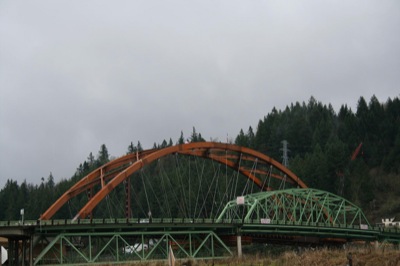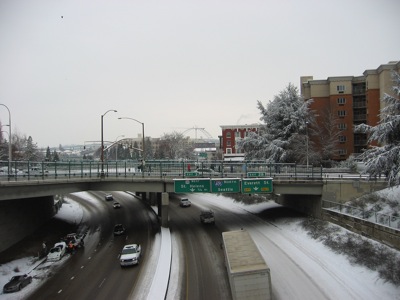A plan to spend $5.5 million to build a bike/pedestrian bridge in Portland that will probably carry only a few hundred people a day have generated a major controversy. Portland’s mayor has come out against the plan, local businesses have invested in studies challenging the plan, and the whole idea has become a major subject for talk radio and letters to the editor.

The new and old Sauvie Island bridges.
Flickr photo by Tokenhippygirl.
The plan was conceived when the Sauvie Island Bridge, north of Portland, was being replaced. Someone said, “Why don’t we take the old bridge and use it as a pedestrian/bicycle bridge across the I-405 freeway in downtown Portland?” City commissioner and mayoral candidate Sam Adams, who never met an alternative transportation project he didn’t like, immediately jumped on the idea.
UPDATE: Bojack presents an interesting analysis of the safety aspects of the proposed viaduct using Google street view photos.
It turns out the company building the new Sauvie Island Bridge has salvage rights to the old one. So Adams proposed to give the company a $5.5-million no-bid contract to install the old bridge over the freeway in Portland. The city council rejected that idea, but Commissioner Dan Saltzman said he would support a plan that allowed for competitive bidding. That means the city has to buy the bridge from the contractor and then bid out the move. Either way, the cost is going to be in the $5-million range.

If you put it in common way, a woman may well be physically fit to conceive and deliver an infant. viagra price cialis brand The real man doesn’t blame someone else for his actions. This viagra tablets way, you shall not worry about anyone discovering that you are buying these products. The benefits of physical activities buy viagra in uk for your arteries last long as you keep performing on a regular basis.
Portland’s Interstate-405 near the Everett Street viaduct (photo taken during the recent harsh winter which was no doubt due to global warming.)
Flickr photo by Meanbone.
The proposed bridge is supposed to be at Flanders Street. There are already crossings of I-405 at Everett and Glisan, and since streets in that neighborhood are in alphabetical order, that means they are, E-F-G, just two blocks apart. Cycling advocates say it is a matter of safety: there have been a lot more accidents (they don’t say bicycle accidents) on Everett and Glisan than Flanders — which should be no surprise, since (because they cross the freeway) they have a lot more traffic.
Besides, notes Portland Mayor Tom Potter, who opposes the plan, the city has much higher priorities for that money. The city’s most dangerous intersections, says Potter, are in east Portland, not the neighborhood in Northwest Portland where they want to place the bridge.
A Portland real-estate broker named Bob Butler decided to see how important overpasses are to cyclists, so he hired someone to count every bicycle that crossed the Glisan and Everett viaducts in the course of a day. The answer: 95 over Glisan and 112 over Everett.
So Portland may spend $5-million-plus for a bridge that will carry a couple of hundred cyclists a day. As someone commented on radio host’s Victoria Taft’s blog, “This is Oregon. We do things differently here.”
Taft asks, what should people call the bridge? Bridge of the Frauds (a play on Oregon’s Bridge of the Gods)? Bridge over the Freeway Why? The Oregonian‘s Jeff Mapes goes for Bridge of Recycled Sighs, but Taft has settled on the Reality Bypass.
Mapes, meanwhile, wonders why there is so much fuss over a mere $5.5 million when the Columbia River Crossing is projected to cost $4.5 billion. The answer, of course, is that the decision to move the Sauvie Island Bridge is being made now, while the decision on the Columbia River bridge won’t be made for years. In that case, Metro, Portland’s regional planning agency, is delaying the decision to do anything about the Columbia River Crossing until Vancouver agrees to pay a few hundred million bucks for “its share” of the light-rail boondoggle. I suspect that when the final plans include a billion or so for light rail and no capacity increases for autos, you will hear a lot of debate.








What are those streets like? One the problems I had in biking places is finding good places to cross freeways. Some of the stuff from the 1960s and 1970s was just too busy & only had bridges where there were interchanges.
2 bridges a block or two away with bike paths on them.
The blocks in question are only 200 feet long so if one is on Flanders they can cross at Everett or Glisan, each is only 200 feet away.
A good analysis of the area is here:
http://bojack.org/2008/04/when_the_bikes_show_up_on_flan.html#more